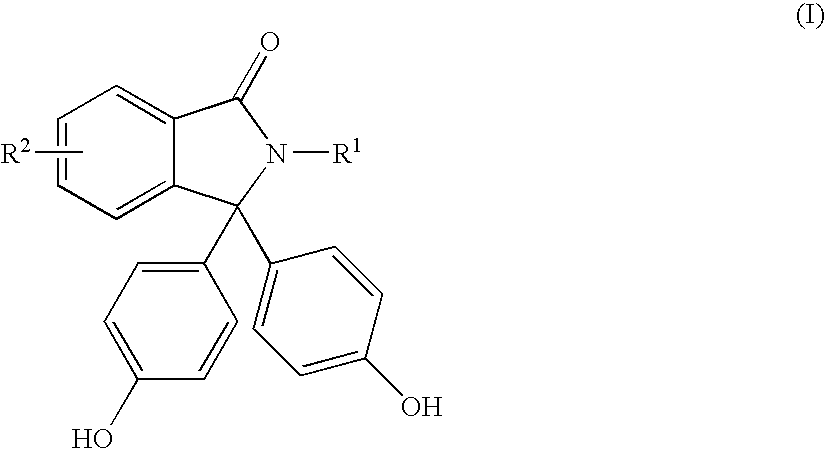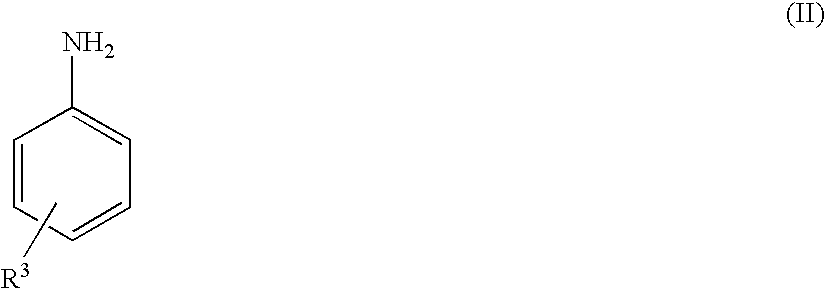Methods for producing and purifying 2-hydrocarbyl-3,3-bis(4-hydroxyaryl)phthalimidine monomers and polycarbonates derived therefrom
a technology of which is applied in the field of producing and purifying 2hydrocarbyl3, 3bis (4hydroxyaryl) phthalimidine monomers and polycarbonates derived therefrom, can solve the problems of long available methods for making and isolating phenolphthalein derivatives, difficult to make and isolate sufficient purity of phenolphthalein monomers, and insufficient purity of phenolphthalein derivatives
- Summary
- Abstract
- Description
- Claims
- Application Information
AI Technical Summary
Benefits of technology
Problems solved by technology
Method used
Image
Examples
examples
[0058]High pressure liquid chromatographic (HPLC) analysis was generally carried out by using a solution of about 50 milligrams of the sample dissolved in about 10 milliliters of methanol. The HPLC instrument was equipped with a C18 (reverse phase) column maintained at a temperature of 40° C., and an ultraviolet detector capable of detecting components at a wavelength of 230 nanometers. A solvent mixture of acetonitrile, methanol and water (containing 0.02% phosphoric acid) of gradient elution was used. The flow rate was maintained at 1 milliliter per minute. Assay was computed by calculating the phenolphthalein content using suitable calibration for phenolphthalein and the weight percent of all other impurities was calculated using the response factor of PPPBP. The purity of PPPBP was calculated by subtracting the amount of phenolphthalein and “others” from 100.
examples 4 to 11
[0064]In Examples 4 to 11, 100 grams of crude phenolphthalein starting materials having a purity of 95 wt % were used to prepare 2-hydrocarbyl-3,3-bis(4-hydroxyaryl)phthalimidine products. The molar ratio of aniline:phenolphthalein:HCl in the reaction mixture was 3:1:1. The reaction conditions are shown in Table 3. The reactions were quenched with 4 wt % aqueous NaOH. 1,2-dichloroethane was added to the biphasic system and the basic layer was separated. The basic layer was mixed with activated carbon (5 weight % based on the theoretical weight of 2-hydrocarbyl-3,3-bis(4-hydroxyphenyl)phthalimidine) and filtered. Aqueous HCl was added (10 wt %) and a precipitate formed which was isolated by filtration. The precipitate contained crude 2-hydrocarbyl-3,3-bis(4-hydroxyphenyl)phthalimidine and impurities. Results are shown in Table 3.
[0065]
TABLE 3APTotalOut-im-PPotherProductTimeTempputpurityimpurityimpurity,purity(hour)(° C.)(g)(%)(%)%(%)425152-154850.930.924.4393.72528152-154860.810.943....
examples 12 to 19
[0069]Phenolphthalein starting materials (200 grams) having a purity of 97-98 wt % were reacted with aniline. The molar ratio of aniline:phenolphthalein:HCl was 3:1:1. The reactions were quenched with 10 wt % HCl to form a slurry. The slurry was filtered to isolate the precipitate and the precipitate was washed with water. Results are shown in Table 5.
[0070]
TABLE 5AmountAPPPTotal otherProductTimeTempof PPOut Putimpurityimpurityimpuritypurity(hours)(° C.)(gm)(gm)(%)(%)(%)(%)1226152-1542002080.370.260.7098.671326152-1542002060.300.410.7498.551431150-1541001090.420.721.9996.871526150-1541001150.620.712.0596.631634150-1541001080.342.122.1995.351726.5150-1541001080.530.462.0496.971830150-1541001070.520.491.8697.141946150-1541501580.470.931.8296.78
[0071]The precipitates were purified by trituration and washing using the same steps as described above. Methanol:water at different ratios as shown in Table 6 were used as triturating solvents. The results are summarized in Table 6.
[0072]
TABLE ...
PUM
| Property | Measurement | Unit |
|---|---|---|
| temperature | aaaaa | aaaaa |
| temperature | aaaaa | aaaaa |
| temperature | aaaaa | aaaaa |
Abstract
Description
Claims
Application Information
 Login to View More
Login to View More - R&D
- Intellectual Property
- Life Sciences
- Materials
- Tech Scout
- Unparalleled Data Quality
- Higher Quality Content
- 60% Fewer Hallucinations
Browse by: Latest US Patents, China's latest patents, Technical Efficacy Thesaurus, Application Domain, Technology Topic, Popular Technical Reports.
© 2025 PatSnap. All rights reserved.Legal|Privacy policy|Modern Slavery Act Transparency Statement|Sitemap|About US| Contact US: help@patsnap.com



